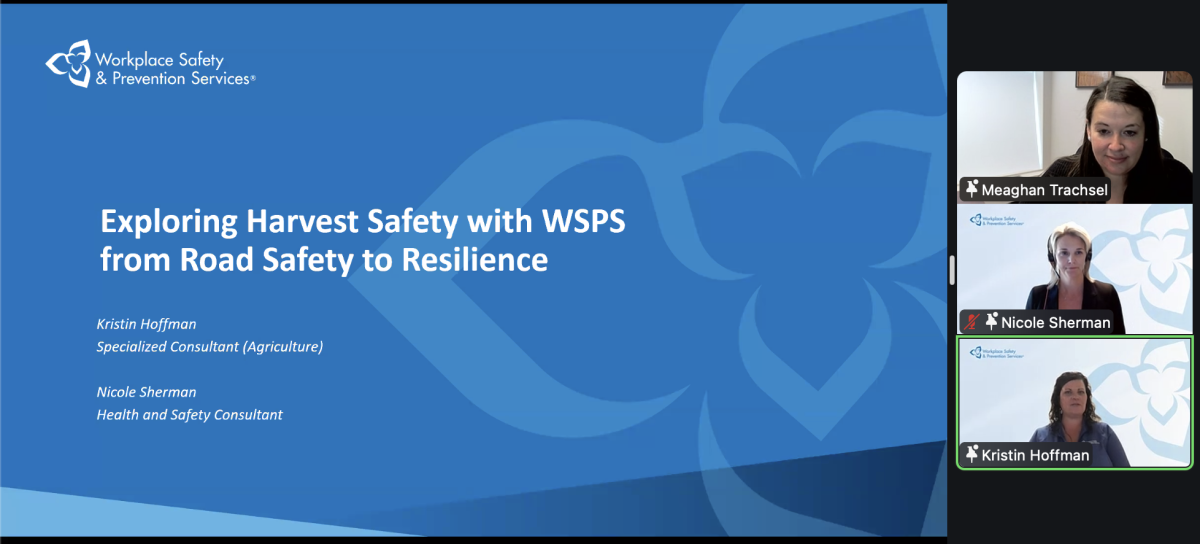High school students across Canada are the target of a new campaign that suggests careers in agriculture as a way to avoid the “typical office job.”
The Canadian Association of Diploma in Agriculture Programs (CADAP) last week rolled out its national initiative, dubbed “Ditch the Office,” including a website and “social media” platforms such as Facebook, YouTube and Twitter, aimed at students between ages 15 and 18.
Agricultural programs across Canada “struggle to compete for new students in a country that is becoming increasingly urbanized and as a result, much less aware of the potential a career in agriculture can offer them,” CADAP said in a release.
Read Also

Exploring Harvest Safety
Kristin Hoffman of WSPS explains measures for increased farm safety around harvest season
“They simply have no idea of the impact agriculture has on their daily lives and the exciting things that are happening within Canadian agriculture,” said Lauranne Sanderson, an associate professor with the Nova Scotia Agricultural College (NSAC) at Truro and president of CADAP.
That said, “we discovered some pretty interesting things in the focus groups we conducted with teenagers,” said Lance Johnson, a senior consultant with Edmonton-based consultancy Drive Solutions Corp., which has been hired to develop and manage the “Ditch The Office” campaign.
“They were all very clear that they didn’t want your typical office job. Participants said they wanted a career that didn’t chain them to a desk, but instead allowed them to potentially travel, meet people and have real impact.
“In an essence,” he said, “they wanted to change the world. It’s very idealistic, but it’s also very exciting to hear this from them.”
The “Ditch the Office” campaign will be based on “a very sophisticated platform that will allow participants to do a little research, shape the messaging into their own words and then broadcast this message across a whole host of social media sites that teenagers are currently using,” he said.
To boost interest among students, CADAP has pledged over $10,000 in cash and prizes toward contests that will run for six weeks from March 1 to May 16.
The main contest is a video competition that allows eligible teenagers the opportunity to submit videos containing their opinions or thoughts on agriculture and how it relates to their daily lives.
Participants can also earn contest points through activities they perform on the campaign’s website, such as viewing videos, answering daily quizzes about agriculture, forwarding links and videos to their friends, posting comments to the forums, submitting photos or designing posters.
Points are then used to calculate weekly winners, who will be announced weekly from Monday (March 8) onward. CADAP also pledged a $2,500 grant for the high school with the most participation points.
Jobs per student
“We’re seeing tremendous demand from the agricultural industry for our students… but the only way we can satisfy the growing need for new agriculture professionals is to get our enrollments up,” said Sanderson, who teaches business and social science.
“The agricultural industry is constantly asking for more grads from agricultural colleges and universities across the country,” she said. “Nationally there are probably four jobs for every student that walks out of our schools with a diploma in hand.”
One of the high school students who took part in CADAP’s focus groups was quoted in the association’s release saying she “had no idea agriculture was so broad.”
Selene Sanchez said that when she heard about “that company who is creating more affordable insulin from plants, it just blew me away.”
Sanchez was referring to SemBioSys, the Calgary biotech company using genetically modified safflower plants to produce insulin.
“It’s exciting to think that I could be involved with something like that… something that can impact millions of people around the world,” Sanchez said.
“We’re there to help provide information, but the beauty of today’s youth is that they’ve grown up in the information age and they’re resourceful,” Johnson said. “All we need to do if nudge them in the direction of agriculture.”
CADAP’s member schools along with NSAC include Lakeland, Lethbridge Community and Olds colleges in Alberta; Kemptville, Alfred and Ridgetown colleges in Ontario; Kwantlen and Fraser Valley universities in B.C.; Macdonald College and l’Institut de technologie agroalimentaire in Quebec; the University of Manitoba and Assiniboine Community College in Manitoba; and the College of Agriculture at the University of Saskatchewan.
“Great stuff”
4-H Canada last week also announced plans for a new interactive website to promote career opportunities specific to the agriculture industry.
“Naturally, many of our partners are involved in the agriculture industry and have expressed continued frustration with employee shortages,” Ken Lancastle, the Canadian 4-H Council’s communications and marketing manager, said in a separate release.
“We’re establishing CareersOnTheGrow.ca as a means of educating our members and others about all the opportunities that exist in agriculture and its related industries. There’s a lot of great stuff going on in agriculture and it’s important youth understand it.”
CareersOnTheGrow.ca is expected to launch later this month, with updated content and job opportunities to be posted “on a regular basis.”
















